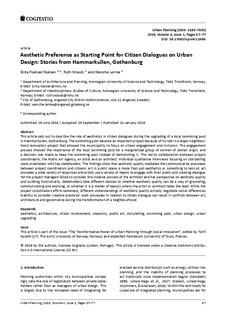| dc.contributor.author | Nielsen, Brita Fladvad | |
| dc.contributor.author | Woods, Ruth | |
| dc.date.accessioned | 2020-02-20T13:30:23Z | |
| dc.date.available | 2020-02-20T13:30:23Z | |
| dc.date.created | 2018-09-30T15:43:13Z | |
| dc.date.issued | 2019 | |
| dc.identifier.issn | 2183-7635 | |
| dc.identifier.uri | http://hdl.handle.net/11250/2642992 | |
| dc.description.abstract | This article sets out to describe the role of aesthetics in citizen dialogues during the upgrading of a local swimming pool in Hammarkullen, Gothenburg. The swimming pool became an important project because of its role in a larger neighbourhood renovation project that allowed the municipality to focus on citizen engagement and inclusion. The engagement process showed the importance of the local swimming pool for a marginalized group of women of Somali origin, and a decision was made to keep the swimming pool instead of demolishing it. This led to collaboration between project coordinators, the Public Art Agency, an artist and an architect. Individual qualitative interviews focusing on storytelling were undertaken with key stakeholders. The findings show that aesthetic quality mediated the communicative processes between project coordinators and citizens. Art in public space is more than just aesthetics or something to look at; art provokes a wide variety of responses and artists use a variety of means to engage with their public and creating dialogue. Yet the project managers failed to consider the creative process of the architect and her perspective on aesthetic quality and building functionality. Stakeholders take different stances to whether aesthetic quality can be a way of grounding, communicating and evolving, or whether it is a matter of beauty where the artist or architect takes the lead. While the project coordinators affirm sameness, different understandings of aesthetic quality actively negotiate social differences. Inability to consider creative practices’ work processes in relation to citizen dialogue can result in conflicts between art, architecture and governance during the transformation of a neighbourhood. | nb_NO |
| dc.language.iso | eng | nb_NO |
| dc.publisher | Cogitatio Press | nb_NO |
| dc.rights | Navngivelse 4.0 Internasjonal | * |
| dc.rights.uri | http://creativecommons.org/licenses/by/4.0/deed.no | * |
| dc.title | Aesthetic Preference as Starting Point for Citizen Dialogues: Stories from Hammarkullen | nb_NO |
| dc.type | Journal article | nb_NO |
| dc.type | Peer reviewed | nb_NO |
| dc.description.version | publishedVersion | nb_NO |
| dc.source.journal | Urban Planning | nb_NO |
| dc.identifier.doi | http://dx.doi.org/10.17645/up.v4i1.1648 | |
| dc.identifier.cristin | 1616272 | |
| dc.relation.project | Norges forskningsråd: 255130/E20 | nb_NO |
| dc.relation.project | Norges forskningsråd: 257660 | nb_NO |
| dc.description.localcode | © Brita Fladvad Nielsen, Ruth Woods, Wenche Lerme. This is an open access article distributed under the terms of the Creative Commons Attribution 4.0 license (http://creativecommons.org/licenses/by/4.0), which permits any use, distribution, and reproduction of the work without further permission provided the original author(s) and source are credited. | nb_NO |
| cristin.unitcode | 194,61,50,0 | |
| cristin.unitcode | 194,62,40,0 | |
| cristin.unitname | Institutt for arkitektur og planlegging | |
| cristin.unitname | Institutt for tverrfaglige kulturstudier | |
| cristin.ispublished | false | |
| cristin.fulltext | original | |
| cristin.qualitycode | 1 | |

